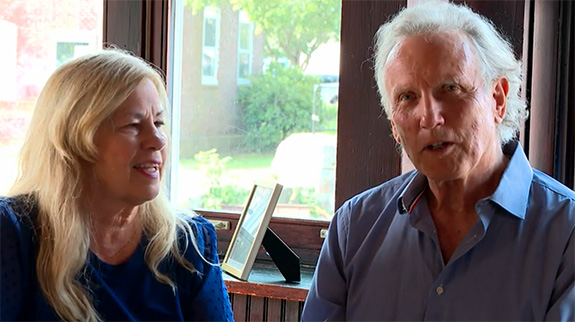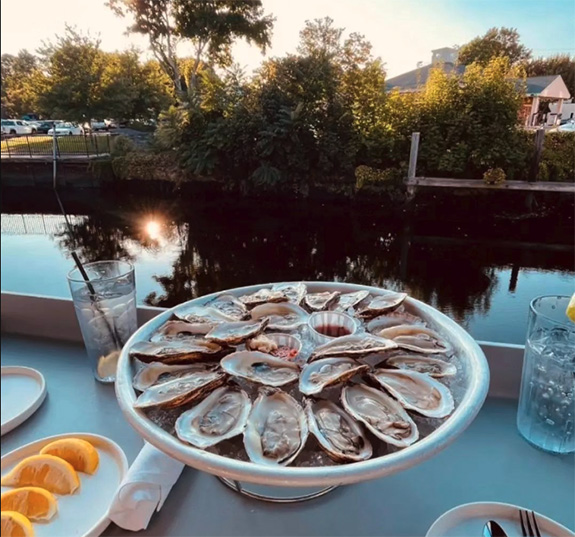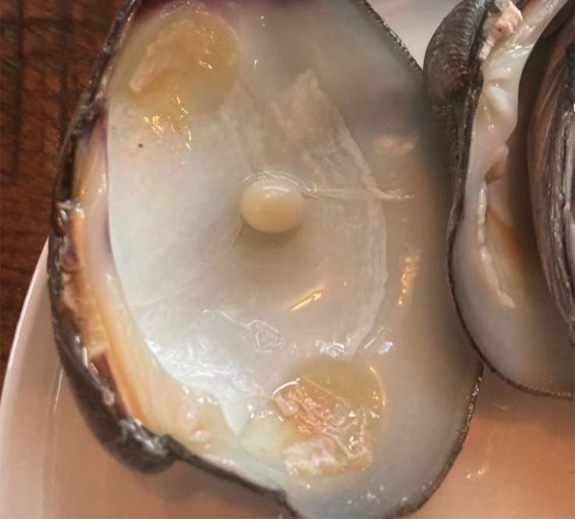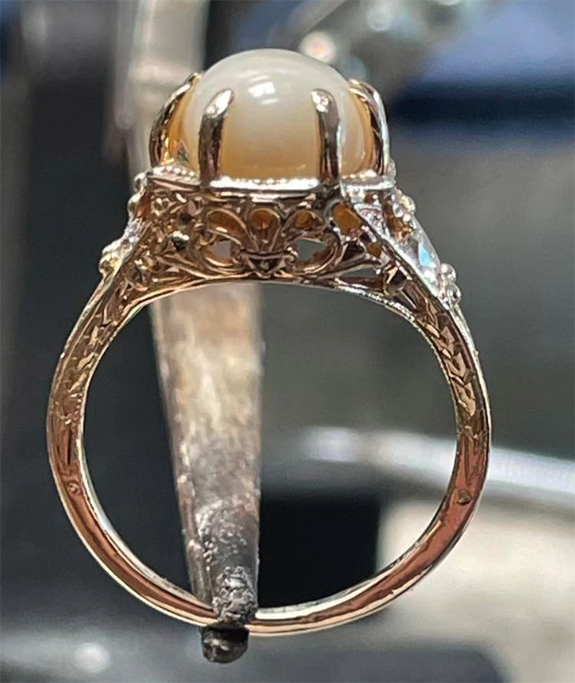July 27th, 2023
Rhode Islander Ken Steinkamp recently proposed to longtime sweetheart Sandy Sikorski with a natural pearl engagement ring that is truly one of a kind.

You see, the 9.8mm quahog pearl at the center of Sikorski's ring was originally hiding in an appetizer at their favorite eatery, The Bridge Restaurant and Raw Bar in downtown Westerly.

According to a report by Providence NBC affiliate WJAR, the couple was enjoying a dozen quahogs (pronounced Kwo-hogs) back in December of 2021 when they got a surprise of a lifetime.
Steinkamp described the scene as only one delicious clam remained on the tray.
"No, no, no. You have it. You really like these," Steinkamp said.
When Sandy attempted to slurp down the tender morsel, something was not quite right.

"I tasted this big round thing in my mouth and I was thinking, 'What the heck is this?" she recounted.
She extracted the foreign matter with a napkin and placed it on the table. Her sister-in-law took a quick look and asked her if she had lost a tooth.
What they quickly learned was that hard, round item that Sikorski nearly consumed was a very rare natural pearl.
"What were the odds of a pearl being inside the shell?" Sikorski wondered out loud.
A local jeweler later told her that the odds of finding a natural pearl of that size in a perfectly symmetrical oval shape was one in a million.

On July 8, Steinkamp got down on one knee and proposed to his girlfriend of four years with a pearl ring that meant so much to both of them. Of course, she said, "Yes."
"We felt that [the pearl] was kind of a signal, or an odd bit of synchronicity," Steinkamp told WJAR. "And we said, 'This would be a great engagement ring.'"
Just recently, the couple returned to The Bridge to celebrate their engagement and to dish all the details about their extraordinary gem.
Pearls found in clams are classified as non-nacreous and have a porcelain-like appearance. Pearls grown in oysters present a deeper glow resulting from layers of nacre that refract the light.
Natural pearls are organic gems, created by a mollusk totally by chance, without human intervention. Cultured pearls, by comparison, are grown under controlled conditions, where a bead is implanted in the body of the mollusk to stimulate the secretion of nacre.
A natural quahog pearl is very rare, and a single specimen — depending on the size, quality and shape — can be worth thousands of dollars.
Credits: Couple screen capture via NBC10, turnto10.com. Pearl ring and clam shell images via Facebook / Sandy.bald.7. Clam platter image via Facebook / BridgeRI.

You see, the 9.8mm quahog pearl at the center of Sikorski's ring was originally hiding in an appetizer at their favorite eatery, The Bridge Restaurant and Raw Bar in downtown Westerly.

According to a report by Providence NBC affiliate WJAR, the couple was enjoying a dozen quahogs (pronounced Kwo-hogs) back in December of 2021 when they got a surprise of a lifetime.
Steinkamp described the scene as only one delicious clam remained on the tray.
"No, no, no. You have it. You really like these," Steinkamp said.
When Sandy attempted to slurp down the tender morsel, something was not quite right.

"I tasted this big round thing in my mouth and I was thinking, 'What the heck is this?" she recounted.
She extracted the foreign matter with a napkin and placed it on the table. Her sister-in-law took a quick look and asked her if she had lost a tooth.
What they quickly learned was that hard, round item that Sikorski nearly consumed was a very rare natural pearl.
"What were the odds of a pearl being inside the shell?" Sikorski wondered out loud.
A local jeweler later told her that the odds of finding a natural pearl of that size in a perfectly symmetrical oval shape was one in a million.

On July 8, Steinkamp got down on one knee and proposed to his girlfriend of four years with a pearl ring that meant so much to both of them. Of course, she said, "Yes."
"We felt that [the pearl] was kind of a signal, or an odd bit of synchronicity," Steinkamp told WJAR. "And we said, 'This would be a great engagement ring.'"
Just recently, the couple returned to The Bridge to celebrate their engagement and to dish all the details about their extraordinary gem.
Pearls found in clams are classified as non-nacreous and have a porcelain-like appearance. Pearls grown in oysters present a deeper glow resulting from layers of nacre that refract the light.
Natural pearls are organic gems, created by a mollusk totally by chance, without human intervention. Cultured pearls, by comparison, are grown under controlled conditions, where a bead is implanted in the body of the mollusk to stimulate the secretion of nacre.
A natural quahog pearl is very rare, and a single specimen — depending on the size, quality and shape — can be worth thousands of dollars.
Credits: Couple screen capture via NBC10, turnto10.com. Pearl ring and clam shell images via Facebook / Sandy.bald.7. Clam platter image via Facebook / BridgeRI.


